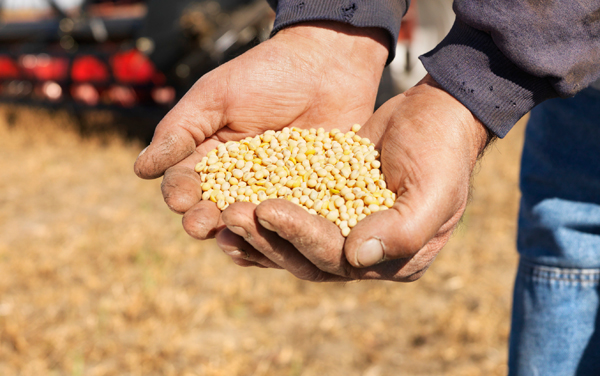While corn prices have fostered adoption of many new high-yield management strategies in the past several years, some growers still look at soybeans as a rotational afterthought — especially where crop nutrition is concerned. But a surprising impetus — the drought of 2012 — may be changing opinions about the effect of aggressive nutrient management strategies.
Abysmal growing conditions in 2012 meant corn plants in many areas of the country simply did not grow, and therefore did not take up nutrients for most of the growing season. That meant nutrients left behind were available for the next year’s crop. In some cases, that meant an accidental experiment with what a soybean crop could do when provided a different level of nutrition.
“The thought among agronomists is that the fertilizer that was applied to the corn crop in 2012 wasn’t fully used, and in some regions, hardly at all,” says Ron Olson, Senior Agronomist at The Mosaic Company. “The drought allowed for a carryover in soil fertility, and it was available for soybean crops in 2013, when we experienced some of the best soybean yields ever.”

Recent research conducted by Dr. Fred Below, Professor of Crop Science at the University of Illinois, is showing what nutrients are needed and when they are needed to optimize soybean yields. In particular, his research has shown that during peak growth, an acre of soybeans can take up nearly 17 pounds of fertilizer each day. While an acre of corn takes up nearly double that amount during peak growth — about 32.5 pounds — it’s clear that more aggressively managing soybean fertility can have a profound effect on yields in the right situation.
In the past, growers often fell into one of two camps: those who fertilized soybeans with potassium, and those who planted soybeans and left the fertility to Mother Nature. However, this recent research is indicating that soybeans have more complex nutrient needs than previously thought, and that they need those nutrients throughout the entire growing season.

“Both phosphorus and sulfur play bigger roles in soybean production than we gave them credit for,” Olson says. “Phosphorus is needed at similar levels in soybeans as it is in corn. And nitrogen is critical to soybean growth. Thinking that soybeans add nitrogen to the soil for the coming corn crop is inaccurate in today’s farming.”
In fact, soybeans only produce about 60 percent of the nitrogen they require, according to Dr. Below’s research, meaning that there is no carryover nitrogen for next year’s corn crop. The research findings also show that balanced crop nutrition is critical in the early-, mid-season and late-growing phases for soybeans, further demonstrating the need for a fertilization plan that will provide season-long nutrient availability.
For farmers wanting to invest in a new strategy to increase soybean fertility, Olson suggests setting a yield goal and starting the planning process by asking several questions about their previous years’ production.
“Farmers should make a statement,” Olson continues. “Start with setting a goal — maybe 10 percent higher than your five-year average. And don’t be afraid of missing that goal at first. Building soybean fertility will be a process.”
As for the questions to ask in determining what can change in a soybean field, Olson lists the following:
-
Am I currently fertilizing my soybeans?
-
If so, am I using the right nutrients on soybean plants?
-
Am I getting soybeans planted at the right depth and with the right spacing?
-
Am I controlling weeds in my soybean field?
-
Have I created resistant weeds somewhere by relying on only one technology?
-
Have I controlled insects, like aphids?
-
Am I aggressively scouting my soybean fields for problems?
-
Do I know the biggest threats to soybeans in my area?
-
Am I minimizing stresses put on the soybean plants?
-
Are my soil tests up to date?
-
Have I chosen the right variety of soybeans for my field conditions and growing region?
-
Am I shifting my varieties every few years?
-
How open have I been to using fungicides to control late-season diseases, or even twice a year?
-
Do I know if I have soybean cyst nematodes?
“Once farmers realize where they can make changes, the yields will follow,” adds Olson. “Because as much as 60 percent of yield depends on balanced crop nutrition, farmers need to manage stressors and field conditions well to optimize the plant’s potential.”
Although previous theories about soybeans meant they were often considered “secondary,” it’s important to treat soybeans as a primary crop if increasing yields is part of the overall goal. It may even lead to increased efficiencies down the road. By fertilizing soybeans and putting down the nutrients they require ahead of the growing season, they will not be robbing existing nutrients from the soil that may be needed for the following year’s corn crop. For instance, corn and soybeans use approximately the same amount of potassium throughout the growing season, but corn requires nearly twice the amount of phosphorus as soybeans. Adding phosphorus to soybean fields ahead of planting means soybeans can take up what they need, and not deplete the nutrient from the field entirely, as it would cost more the following year to adequately apply phosphorus to a cornfield.
Growers can also use a more impactful soybean strategy to create efficiency in double-crop systems. For instance, farmers who invest in high-yield wheat and fertilize that wheat in the fall can put the needed soybean fertilizer down at the same time. The wheat will only take up what it needs from the soil, leaving the nutrients that were added for the soybeans. This reduces the need for another fertilizer application in the late spring or early summer, when beans are planted.
While increasing crop nutrition is an expense that most farmers won’t realize until harvest, there are signs that can show the more immediate benefits of greater soil fertility.
“Properly fertilized soybeans will be greener and healthier,” Olson states. “Depending on the variety you choose, you may even see an increase in size early in the growing season. Properly nourished plants will resist diseases better throughout the growing season, and will likely begin to flower and set pods earlier. This gives the plants a chance to put on more pods because they are taking advantage of sunlight throughout the entire growing season. And with the right nutrition, some plants may even have the potential to set more pods per plant, and more beans per pod. All of that will lead to higher yields that can be confirmed once harvest comes.”
Key Nutrients for Better Soybean Fertility
Potassium helps develop strong root growth, and also helps guard the soybean from drought, pests and other stresses. It also aids in the process of photosynthesis, helping the plant grow stronger and healthier.
Phosphorus is critical for root development, and also for seed development and growth. It is extremely important in the photosynthesis process, helping to convert sunlight to energy for the plant. Phosphorus tends to attach itself to proteins, so in soybeans, it is highly concentrated in the seeds within the pods.
Nitrogen is important for increasing the protein content of a plant, as well as moving water efficiently throughout the plant. Soybeans only produce between 40 and 60 percent of the nitrogen they require, so adding nitrogen to soybean fields helps optimize the health and yield of the plants.
Sulfur is required for legumes to fixate nitrogen from the soil. It also plays a large role in seed development. Sulfur is also an important nutrient for the photosynthesis process.
Zinc is critical in the early growth stages of soybeans, and is a necessary nutrient to produce chlorophyll and carbohydrates. Plants deficient in zinc will suffer from shortened internodes and stunted leaf growth.
Boron aids soybeans in developing proteins and assists in seed setting. Boron is best applied to the soil (versus foliar applications), but can be toxic at high levels. Proper rate and placement of boron are essential.
Copper is an important nutrient for soybeans. It is necessary in the development of chlorophyll. However, it is needed in extremely small amounts, and can be toxic to plants at high levels, so be sure applications are done correctly to reap the full benefits.